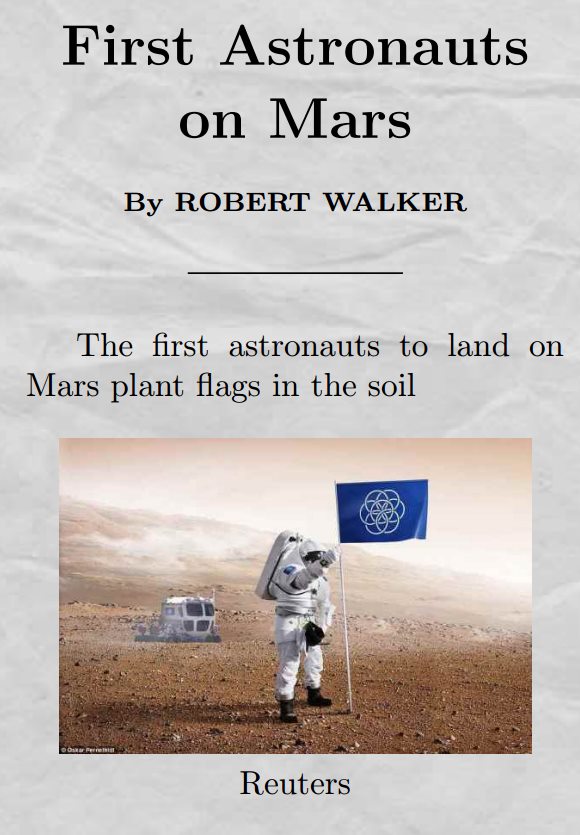
Yes it would be an exciting day when the first human steps on the surface of Mars, and a matter of prestige for those concerned. This is something I have read about since a child, and would be as excited as anyone. But it might quickly change to dishonour if it is found that they introduced reproducing Earth micro-organisms to Mars. They might enter the history books as the people who contaminated Mars irreversibly. To dramatize the idea, here are a series of fake newspaper stories in a (hopefully) "alternative future" in which humans accidentally introduce Earth life to Mars, then regret what they did.

(photo shows Artist's impression of a human astronaut on the Mars surface holding Oskar Pernefeldt's proposed International Flag of the Earth )
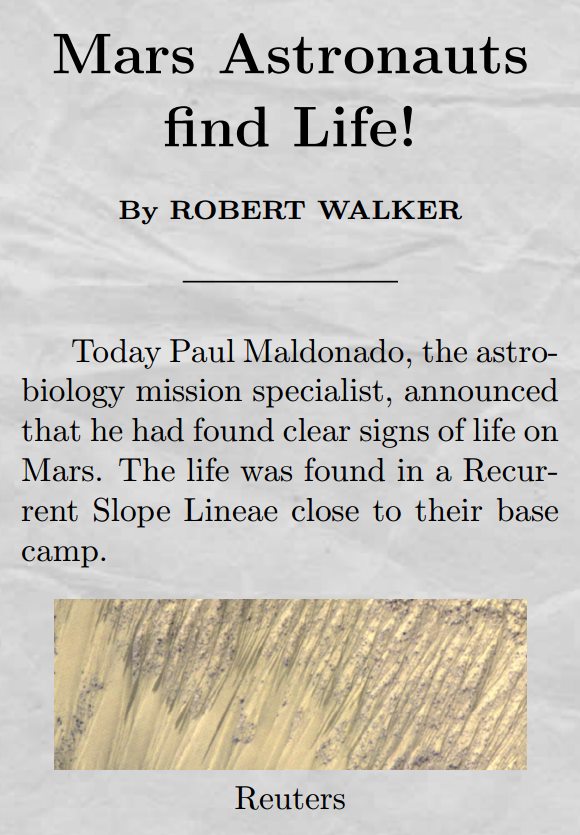
(Photo is actually of a slope with RSLs from this paper)
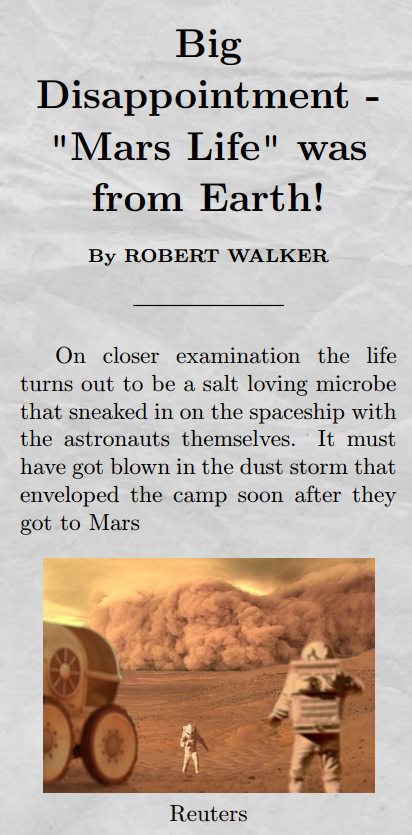
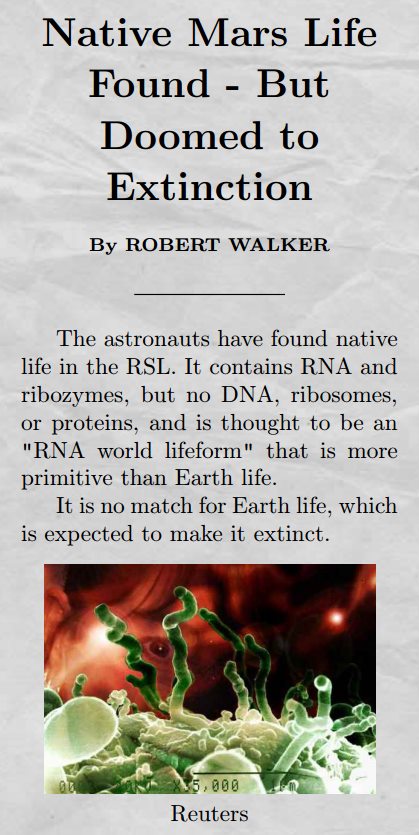
(Photo is of nanobes from "New life form may be a great find of the century" (1999), at one time thought to be relic RNA world life here on Earth)
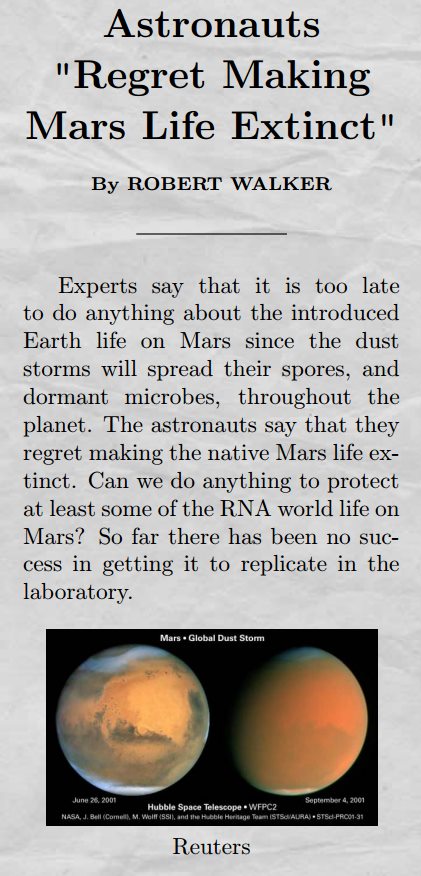
(Photograph is Hubble's photograph of a Global Mars dust storm from 2001 )
Actually, if the Earth life they found was salt loving haloarchaea, they don't seem to produce spores (archaea generally probably don't). Instead they have other ways of coping with desiccation including dwarfing of the cells, protective capsules and probably forming dormant states. That's why the article says "spores and other dormant states".
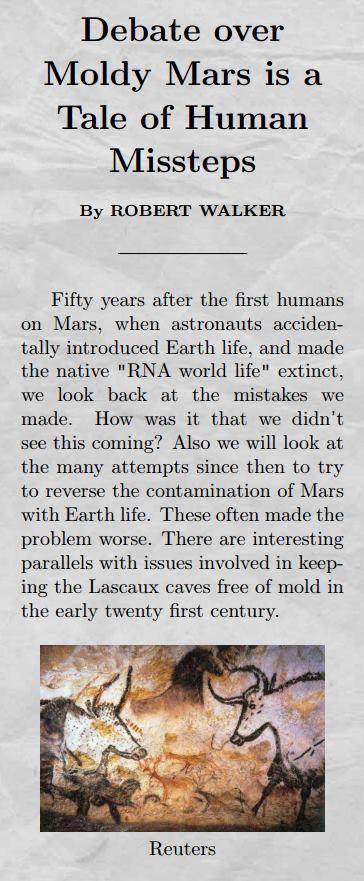
The Lascaux cave painting photo is by Prof Saxx.
I created these fake newspaper stories using this online free newspaper generator. I invented the name of the astrobiology mission specialist using this online fake name generator.
This short story describes a mission similar to NASA's plan for safe zones - based on finding Mars life easily (in my online book) according to which they would land the humans inside a region which they judge "safe to contaminate" with Earth microbes. Outside of that, not too far away, they'd have a potentially habitable and biologically interesting site for them to explore using sterile rovers, such as one of the sites with Recurring Slope Lineae. So what happens if the party get caught up in a major Mars dust storm, and then the dust carries microbes from their base to the RSL? That's the basis for this story. My first draft of it had a crash of the human occupied ship, as in Crashes of spacecraft on Mars (in my online book), but I removed it to keep the storyline as simple as possible.
Why not let those first steps be taken by a telerobot instead, operated by a human in orbit around Mars?
Advocates for Mars surface colonization often talk about the inspiration of a human surface mission. But we have seen from the rover missions what fondness the general public have in their hearts for our robotic emissaries on Mars such as Pathfinder, Spirit, Opportunity and now Curiosity. Also look at how much interest and excitement there was for the Dawn mission to Ceres and the New Horizons mission to Pluto, and indeed, the Philae Lander.
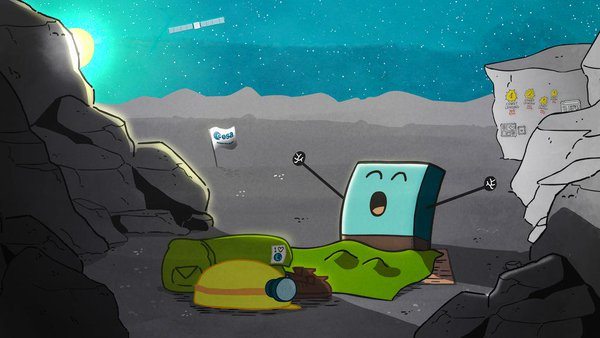
Incredible news! My lander Philae is awake!
ESA Rosetta Mission tweet after first successful landing on a comet.
I am sure this would apply even more so to telerobots on the Mars surface operated by humans in orbit around Mars. There would be the human stories of the astronauts orbiting Mars, their spectacular views of Mars like the Earth views from the ISS but the planet is Mars, and then this story of the avatars they are driving on the surface of Mars, all the photos of the planet as seen by them from orbit, and the terabytes of streaming video from the Mars surface returned to Earth. For many I think that telerobots on Mars would be more exciting and interesting than a surface mission, especially if the reason for doing it this way is also well understood. And if this is the best way to find life there, and they do find life, then that by itself would make it of tremendous public interest.
Also for Mars enthusiasts a telerobotic mission, with live immersive 3D landscapes you can follow every step of the way - that would be a very exciting mission to follow from Earth. You could even go back and look at rocks and other features close up in 3D which the team had passed earlier in the day, even weeks ago, and perhaps spot something of interest there that they never noticed. We'd probably get citizen science projects just looking for features that the team had missed as they drove across the landscape via telepresence.
The astrogeophysicist Christopher McKay has talked about the need for all exploration of Mars to be biologically reversible in the sense that, if necessary, we can remove all the microbes we brought to Mars, at least until we have a better understanding of Mars. He has also suggested that if we find a second genesis of life on Mars, biologically unique and different from Earth life, we might want to adapt Mars, to make it more habitable for native Martian life even if the result does not make it into a planet suitable for Earth life.
The idea is that if we find interesting life on Mars, we can remove all our contamination from the planet and leave Mars for the Martians instead, even if they are just microbes - so that we can study the biology there. Maybe even get to restore the early Mars climate, if we can find a way to do it.
Here is the same idea in his paper from 2007, Planetary Ecosynthesis on Mars: Restoration Ecology and Environmental Ethics. At the time he wrote this article, back in 2007, he thought it was possible for not just robots, but also humans to explore Mars in a biologically reversible way. Here is how he put it:
"Scientifically, having another example of life expands the scope of biology from one to two. There may well be significant advances in medicine, agriculture, pest control, and many other fields of biological inquiry, from having a second type of life to study. I would argue that if there is a second genesis of life on Mars, its enormous potential for practical benefit to humans in terms of knowledge should motivate us to preserve it and to enhance conditions for its growth.
Observations of Mars show that currently there is no global biosphere on that planet and if life is present it is in isolated refugia or dormant. It is possible that life present on Mars today is at risk of extinction if we do not alter the Martian environment so as to enhance its global habitability.The utilitarian arguments presented above indicate that we should alter Mars to allow any indigenous life to expand and form a global biosphere even if the resulting biosphere is never a natural home for life from Earth or humans.
"...This discussion has implications for near-term exploration of Mars by robots and humans. Until we know the nature life on Mars and its relationship – if any – to life on Earth, we must explore Mars in a way that keeps our options open with respect to future life. I have argued elsewhere that this means that we must explore Mars in a way that is biologically reversible. Exploration is biologically reversible if it is possible and practical to remove all life forms carried to Mars by that exploration. Because of the high UV and oxidizing conditions on Mars, biological reversibility is achievable.
"... Previous missions to Mars, such as the Pathfinder mission and the two MER rovers, have carried microorganisms to the martian surface where they remain dormant as long as shielded from ultraviolet radiation. To reverse this contamination already present on Mars, it would be necessary to collect all metal objects within which microbes could remain viable. Furthermore, the soil at crash sites and in the vicinity of landers that had come into contact with the spacecraft would have to be thrown up into the atmosphere where it would be exposed to sterilizing ultraviolet radiation. A similar approach can be used to reverse the contamination from human bases."
Quote from his Planetary Ecosynthesis on Mars: Restoration Ecology and Environmental Ethics
This was written before the Phoenix lander's discoveries, and the new extremophiles found in many Mars simulation experiments on Earth. At the time he wrote that, then it was reasonable to suppose that all you have to do to reverse contamination after a human landing there is to collect all the metal objects on Mars and also throw up the soil around the base into the air so that it gets sterilized by the UV radiation from the Sun.
However since then we have found that many microbes far from being sterilized in seconds, are capable of withstanding hours of direct Martian surface UV before they die (and indefinitely in partial shade or protected by a thin layer of dust, gypsum or rock), see Ultraviolet radiation (in my online book). Also, we now know of many more potential habitats for life on Mars than we knew about back then, including several types actually on the surface, such as the RSLs and Nilton Renno's droplets on ice / salt interfaces. So far there is no way to tell if any of those are habitable but some or even most of them might be.
This makes it very challenging to do human missions to Mars such as the ones proposed by NASA to explore Mars in a biologically reversible way. See 35 minutes into this video by Cassie Conley (answer to an email question from me). She says that this is discussed, sounds like a really good idea, but when you try to figure out how to do it, then it becomes really challenging and she wasn't aware of a mission with humans to the surface that proposes to be able to do that.
It may still be possible for the robotic missions to be reversible, indeed most think they have been so far, as they can be sterilized far more thoroughly than a human lander. So I'm not sure what his latest thinking is on this, if he has dropped the idea of biologically reversible exploration of Mars. Most of his main papers on the subject are from before the Phoenix lander results about Mars.
Incidentally, though I am right with him about the need to protect native Mars life if there, I'd like to look a bit closer at one of his other points. He doesn't think we need to protect a lifeless Mars. I'm not sure what his latest thinking is on this but in his 2007 paper he writes:
"If there is no indigenous life, these utilitarian arguments indicate that we should alter Mars to support life from Earth even if this never results in a biosphere that can be a natural home for humans.".
So first, yes, if we had warp drive and had many Mars like planets were within easy reach of Earth, Mars with uninhabited habitats might well be of little science value. There must be so many of them in our galaxy, so we can just warp to another solar system to find another one if we want to find out what happens on a pristine Mars without any introduced Earth life.
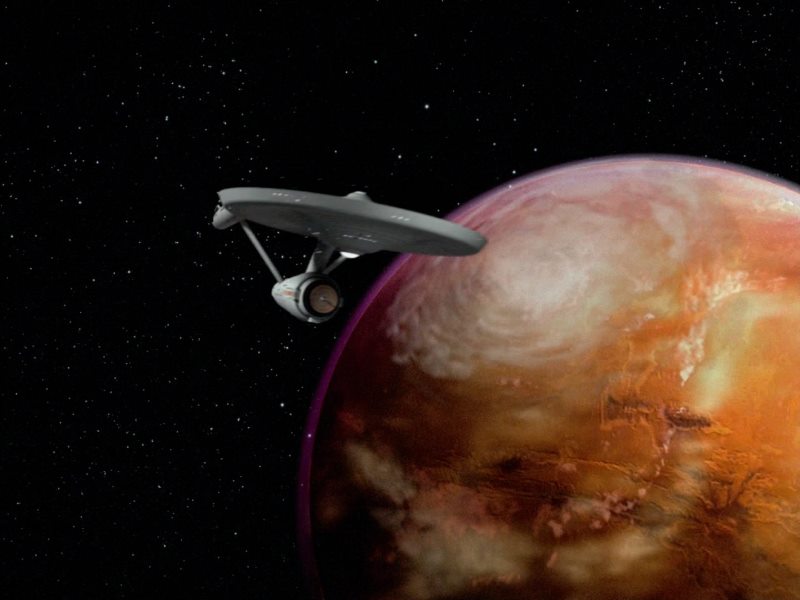
Star Ship Enterprise flying past a planet resembling Mars, from opening credits of remastered Star Trek original series. If we had warp drive and there were many planets like this in our galaxy within easy reach of Earth, then Mars in its pristine state might not be of much scientific value.
However as we are now, we don't have warp drive. It does us no good that our galaxy probably has numerous Mars like planets as we don't yet have any realistic way to explore any of these other planets close up. We are so lucky to have a Mars like planet, and a Venus like planet as well as Earth in our own solar system. If they weren't there we'd have no way to study such planets at all.
How far did the chemistry on Mars develop in the direction of evolution of life? What has happened to the habitats on Mars that actually have organics in them, from comets, asteroids, or made locally through abiotic processes? Do we have "almost alive" complex chemistry, or just simple chemistry and tarry organics like the tholins? We could learn a lot from this about how difficult or easy evolution is, and what typically happens on Mars like exoplanets. We could also learn a lot about how to disentangle effects of biology and abiotic processes. Not just study what happened in the past, but study the abiotic processes such as the RSLs ,the flow like features, effect of humidity in the atmosphere and the frosts on the surface, deep subsurface hydrosphere, in the present day, many slow processes all working without biology over an entire planet.
Once you start to think this way, to think of Mars as an example of a typical Mars like exoplanet, in our own solar system, perhaps it puts these ethical and utility value discussions in a new light. For as long as there are habitats for Earth life on Mars, inhabited or uninhabited, almost any scenario where present day pristine Mars would be of great scientific interest I think, "as is" as an exoplanet analogue or for its value for exobiology. Just because of its uniqueness, for us, as the only such planet in our solar system.
If you think about it this way, of Mars as like an exoplanet in our own solar system, of great science value just "as it is" then the best places to introduce Earth life right now are places where no life can survive without our help. Such as the possibly vast lunar caves, see my An astronaut gardener on the Moon - summits of sunlight and vast lunar caves in low gravity in MOON FIRST Why Humans on Mars Right Now Are Bad for Science . The moon is the closest and safest place to try this.Or in free space - if we use the asteroid belt to make large colonies turning slowly for artificial gravity, see my Asteroid Resources Could Create Space Habs For Trillions; Land Area Of A Thousand Earths.

The idea of colonizing asteroids goes back at least as far as Dandridge MacFarlan Cole and his 1963 book ‘Exploring the Secrets of Space: Astronautics for the Layman’ written more than a decade before Gerard O'Neill's pioneering work. He suggested hollowing up an asteroid, by controlled use of nuclear devices, which melts it from inside. It's filled with water first which would turn into steam and expand making it into a "bubbleworld" as such a construct has come to be called. You then spin it for gravity. This rather charming 1960s illustration shows the concept.
This shows his concept from outside and inside

The asteroid, once expanded, would be 20 miles long and 10 miles in diameter, and have an internal surface area of 600 square miles (60 by 10 miles) and would support a colony of 10,000 to a million people. The artwork is by the space artist Roy Scarfo.
More on him in the article in Centauri Dreams, and
Nowadays the idea is rather to use the asteroids as a construction yard to get materials which we'd use to build space colonies, but it's much the same idea. You might think the asteroids are too far from the sun, but first, we can start with NEOs and we can move the materials from the asteroid belt to construct stations that orbit Earth or anywhere else. But as well as that, it's easy to make a thin film mirror to concentrate sunlight as much as you like. We could build such colonies, with plenty of sunlight, right out to Pluto and beyond, still using our sun as a source of illumination.
Or we could use the lunar caves. The cave entrances on the Moon probably open out into vast lava tube caves which in the lowe luna gravity can be up to kilometers in diameter - and the Grail data suggests some of them are over 100 kilometers long. Potentially these could be as vast inside as an O'Neil colony. See Instead of terraforming Mars in a multi-millenium project, why not terraform a lunar cave in a multi-decade project?
See also my answer to "Why not send Earth life to Europa" in Plenty of places to experiment with sending life to other places in our solar system - Asteroid belt resources, NEO's, caves on the Moon
Also we can work on making Earth more habitable, which could support many times its current population of humans if we used the technology suggested for habitats in space, for instance with floating sea cities, or habitats in deserts, self enclosed like a space colony so having minimal impact on the rest of the Earth, even, for instance, bringing water to deserts that have recently been denuded by human activities. I cover those in What about Earth deserts? and Seasteading in my MOON FIRST Why Humans on Mars Right Now Are Bad for Science.
Meanwhile, why not continue to explore Mars in a biologically reversible way, even if all its habitats are uninhabited? Especially, why embark on non biologically reversible exploration with humans so quickly, as early as the 2030s or 2040s? Mars "as is" is of great scientific interest as a planet that used to be as habitable as Earth. Even if it doesn't have life and never had life - it gives us a precious opportunity to study a terrestrial planet of that sort, small, cold, habitable early on. The nearest Mars-like planet outside our solar system is likely to be many light years away.
Then there's another consideration too. If we do decide to introduce Earth life to Mars, there may be many possible final states Mars could end up in.

Example end states of introducing Earth life to Mars, as covered in Imagined Colours Of Future Mars - What Happens If We Treat A Planet As A Giant Petri Dish?
How do we direct it or choose intelligently between those end states at present?
We have often found on Earth that our introductions of new lifeforms don't go exactly to plan even they are worked out in advance, and with a fair bit of experience of introducing Earth life to new places on Earth before. It's even more unpredictable when it's an accidental introduction. So we can expect this unpredictability even more so when it is an accidental introduction of whatever microbes sneak on board the first human ship to land on Mars.
For instance there's Cassie Conley's idea of a lifeform that accidentally turns most of the water on Mars to cement. There must be many ways in which unintended microbes on Mars could mess up our plans to transform Mars into a new form of biosphere. See Closing off future options - hard enough to roll back introduction of feral camels to Australia, never mind of microbes to Mars (in my online book).
As a result of our new understanding of Mars it seems really tricky to send humans to the Mars surface in a biologically reversible way. Apart from anything else, our spacecraft must not crash. How can we guarantee that? See Crashes of spacecraft on Mars - robotic or human occupied - why it's so hard to land there (in my online book).
Well actually there might be one way that we could do that. Not so much guarantee that our spaceship won't crash, but guarantee that no life will escape if it does. However the result is a severe limitation as we have to use a featureless metal sphere with probably no airlocks or windows. That's because featureless spheres are really strong and could potentially be guaranteed not to be breached. Even a hollow spheres can withstand just about anything, and perhaps the capsule could be guaranteed to remain intact, or at least, crushed slightly but not breached, after a crash on the surface?
If so, arrange for your sphere to enter the Mars atmosphere at a shallow angle, to ensure that it slows down to terminal velocity of a few hundred miles per hour, with a human being inside. It then decelerates to the surface, via skycrane,or whatever system is used. Because it is bound to slow down at least to terminal velocity then even if all systems fail, it would hit the surface at at most a few hundred miles per hour. If it crashes, the human would not survive, but a sphere can survive such a crash if it is made of strong materials. Perhaps make it of solid tungsten, which has the highest melting point of all metals, at 3,410 °C (6,170 °F).
Hollow spheres (rocket parts) often re-enter the much thicker Earth atmosphere and survive intact to the surface. This hydrazine propellant tank from a rocket: 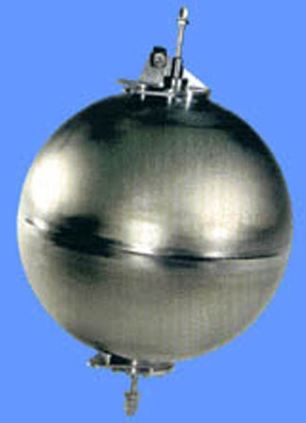
survives to the surface looking like this
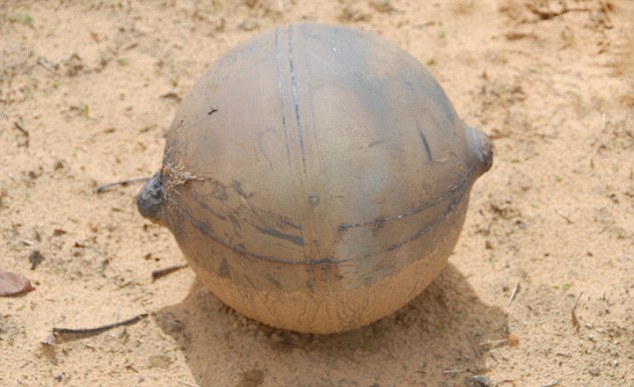
If all goes well, the human inside the sphere would land on Mars and then could be lifted off again - but of course can never leave the sphere or even look outside directly (as it is opaque), so I'm not sure if this would be thought worth doing. Could you make a transparent sphere that's as robust as this? How could a transparent sphere be this strong?
Perhaps one way to make this into a potentially worthwhile mission is to arrange it so that the human inside communicates via telepresence. They control a rover on the surface, and the advantage is that this mission puts the rover so close to the sphere that you have no light speed delay at all. Perhaps the rover carries the sphere containing the human or humans as cargo. Could that be worth doing?
If:
- then it would surely be biologically reversible. Just lift the sphere off Mars somehow at the end of the mission, to reverse the contamination of Mars by the Earth microbes inside the sphere.
Another suggestion for a potentially biologically reversible human mission is to send humans to Olympus Mons.
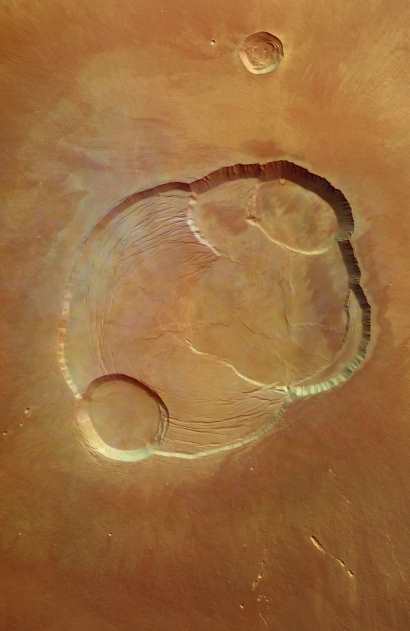
Olympus Mons Caldera Region This might be the area on Mars most biologically isolated from the rest of Mars of anywhere, due to the thin air, high altitude, and the caldera walls. But it is a difficult place to land technically, and also - would even this be a biologically reversible place for a human base on Mars?
The value of the Olympus Mons Caldera region is that it is so high above the surface that the air is very thin and there is almost no dust. That's why it was suggested as a destination to help with planetary protection in an article in The Space Review. It's a major challenge to do this with present day technology however. See Rob Manning's talk on the Space Show where he talks about the challenges associated with landing a spaceship at a high altitude on Mars, where the air is so thin, so the aerobraking much less.
In the space settlement article, they are suggesting a future with new technology with human bases already on Deimos. Some of the technologies Rob Manning mentions could be relevant such as deployable extending heat shields, or using larger parachutes than any of the ones tested supersonically to date. In any case, there's the same problem as with other human landings - we are unlikely to have 100% reliable landing systems.
Yes, if there is anywhere on Mars, where humans can land in a biologically reversible way, then this crater at the summit of Olympus Mons might be it. Or if not biologically reversible completely, perhaps in a way that keeps the landing site separate from the rest of Mars.
However, even with your target the caldera at the summit of Olympus Mons, a failure during approach to Mars, entry, descent or landing could easily land you somewhere else, hundreds of kilometers away. And would a human party - say inside the Olympus Mons caldera - really be biologically insulated from the rest of Mars? Also after a crash there? And would such a landing be biologically reversible in the future, if we need to remove the spores from Mars?
I think it would take a lot of research, including missions to find out more about Mars, to be sure of this. If the mission is not completely biologically reversible, you always have the possibility of an "Oops!" moment where you realize you have introduced Earth life to Mars, can't remove it, and have found a lifeform there you want to preserve or a biology such as ancient RNA based life, and can't do anything to prevent its eventual extinction. I.e. the scenario in the story at the start of this article.
You can put plant seeds on the surface, as these can be sterilized. You can grow plants with hydroponics and aeroponics. The difference here is that with hydroponics the plants grow directly in water, and in Aeroponics you use a mist, so it needs less water (which may be useful on Mars). There are different versions of these technologies. Some depend on micro-organisms but some do not. Instead of having micro-organisms you supply whatever the plant needs in chemical form in either water, or if it is aeroponics, in the mist.
The only life you have is the plant seed. You may use the Mars soil, or just use mist, depending on what you want to do. This microbe free version of hydroponics / aeroponics introduces no risk of contaminating Mars so long as you do it with great care. The only thing that will grow on Mars as a result of this experiment are these plants that you introduced to Mars. Here is a rather charming designer's concept for plants on Mars, called the "Little Prince Rover".
"Little Prince" rover designed to support a single plant on Mars.Since seeds can be sterilized (unlike humans or animals), these could be grown without any risk of contaminating Mars with Earth micro-organisms.
Named after the "Little Prince" who looked after a single rose on his asteroid in the fictional book by Antoine de Saint-Exupéry
It's possible that plants may be the first living Earth colonists of another planet.
So that introduces the possibility that you could have greenhouses on the surface of Mars and these could grow food for the colonists in orbit. They may have plenty to eat in their habitats anyway by then, but you could grow food on Mars too, maybe delicacies or things that grow particularly well on Mars or medicinal plants or whatever. Also you could have large plants, maybe trees (perhaps growing far larger in the Mars light gravity) or whatever else grows best on the surface of Mars.
Sadly, we can't apply these same principles to humans. If only we were like plants and could be grown from sterilized seeds. Well in principle, in the future, it could be possible by adapting the far future idea of "Embryo space colonization". If you could grow a human from an embryo in a sterile environment, and somehow supply them with all the nutrients they need without the symbiotic microbes we all have. Or else, engineer the microbes to make sure they can't survive on Mars. That is just science fiction at present. Supposing it were possible, it has drawbacks, as the Martian colonists would be vulnerable to Earth microbes if they ever left the planet, not being adapted to them, and anyone who left would not be able to return.
Perhaps there may be other future ways to do it. E.g. an impervious spacesuit or rover that can't be damaged even in a crash on Mars, that is also a biobarrier so that no microbes can get in or out and with the outside 100% sterile. This is way beyond anything we have at present however.
The idea of biologically reversible exploration is to give us some breathing space, of a few decades, hopefully, to find out about Mars on a scientific level. To find out if there are habitats there for Earth life and search for exobiology. Meanwhile, you are also building up an infrastructure on Mars and in Mars orbit that would be useful if we did ever decide to send humans to Mars. Or indeed, it could be useful for other things too, anything we might do on Mars.
Perhaps you decide to try ecopoiesis (duplicate the biological transformations of early Earth on much faster timescales), or you follow Chris McKay's proposal to turn the clock back to early Mars, or transform it in some other way, or even grow plants there (plants could be grown on Mars using sterile hydroponics without impacting on any native Mars life, since seeds can be sterilized).
You also continue to have the option to leave Mars as it is, and not try to transform it into a different planet from what it is now. There would be many possible futures still open to you at that point. The future remains wide open.
Also meanwhile we can work on space habitats, closed systems, eventually build city domes on the Moon and large closed systems in the lunar caves, continue to explore ideas for creating larger and larger self sustaining habitats. Whether we eventually get to the point of terraforming entire planets, I think can be left to later, until we have much more understanding than we have now, with these early experiments. So, then it becomes an open path, where instead of closing off futures, we open out to more and more possible futures, and wider vistas at every step. These vistas don't just include Mars either but many destinations for humans in the solar system.
What if we find independently originated life on Mars, or amazingly interesting evidence of early stages that almost reached life but not quite? Should we leave the planet pristine to avoid contaminating it? That would be an exciting prospect seems to me. It's like having our own exoplanet, with its distinct biology, in our own solar system. The nearest terrestrial planet like that, other than Mars, may be light years away. Depending on future technological progress, it might be centuries before we have a similar opportunity - or if life is rare in our galaxy, maybe even millions of years.
I would say why not? Let's go all the way to Mars, and set up colonies in orbit around the planet, but never set foot on it at all, to avoid contaminating it. It is a bit like mountains that are left unclimbed out of respect for the mountain or local beliefs. Not too many of those but the mountains in Bhutan over 6000m are unclimbed.
This is possibly the highest unclimbed mountain in the world Gangkhar Puensum with an elevation of 7,570 m. All mountaineering is prohibited in Bhutan since 2004 out of respect for local religious beliefs.
This would be a future where you have agile rovers on the surface. and increasingly sophisticated humanoid avatars on the surface as well, directed and teleoperated by colonists in orbital colonies. It is a future where the Martian past and present turn out to be amazingly interesting, so much so, that humans never land on the surface in person, in their physical bodies, to preserve a biologically pristine Mars. I, for one, would find that an inspiring future to live in.
The idea that humans on the surface of Mars would contaminate it with Earth life is not much mentioned in the news. Out of dozens of news stories about ideas for human missions to Mars, perhaps only one or two will ever even mention it even as a topic for discussion. But it's frequently mentioned in the academic literature on spaceflight, with many publications debating the issue, and several planetary protection workshops on human missions to Mars. It's just that their deliberations rarely get into the news.
Generally those discussions are focused on the idea that we need to minimize the impact of humans on Mars. It is much rarer to suggest that it is a serious and significant issue which could be a reason to delay sending humans to the surface of Mars, or as a reason to go somewhere else first such as the Moon or the moons of Mars first. I think myself that it is just not good enough to do our best to exploit the brief window of opportunity of a few years before the first human landings or colonization attempts. We simply shouldn't risk destroying such a precious opportunity to make scientific discoveries, on the basis of ignorance, and there is no way we can do it on a basis of knowledge if the humans land on Mars in the 2020s or the 2030s. It is rare to suggest that, depending on what we find, and our decisions, we have a possible future where humans never land on Mars at all but explore it via telepresence instead.
In 1964, George Simpson wrote:
"There is even increasing recognition of a new science of extraterrestrial life, sometimes called exobiology-a curious development in view of the fact that this "science" has yet to demonstrate that its subject matter exists!"
That was before the Apollo landings. But though we have learnt so much by way of astrogeology, and have made great strides in understanding many things in the field of astrobiology, we are yet to shake off that major central issue. Andrea Rinalid in 2007 writes about astrobiology:
"Despite growing attention, the field is still haunted by the curse that evolutionary biologist George Gaylord Simpson voiced more than 40 years ago: "[T]his 'science' has yet to demonstrate that its subject matter exists!"
Now, 52 years after George Simpson wrote his paper, this could be our first opportunity to show that the subject matter of astrobiology exists. It could also possibly be the most major discovery in biology of the 21st century. How can we pass up on such an amazing opportunity and potential "super positive outcome" and ignore the potential issues of Earth microbes introduced to Mars?
Perhaps what we need is a change in the public's perception of how we explore space? Here is a quote from "When Biospheres Collide":
"One of the most reliable ways to reduce the risk of forward contamination during visits to extraterrestrial bodies is to make those visits only with robotic spacecraft. Sending a person to Mars would be, for some observers, more exciting. But in the view of much of the space science community, robotic missions are the way to accomplish the maximum amount of scientific inquiry since valuable fuel and shipboard power do not have to be expended in transporting and operating the equipment to keep a human crew alive and healthy. And very important to planetary protection goals, robotic craft can be thoroughly sterilized, while humans cannot. Such a difference can be critical in protecting sensitive targets, such as the special regions of Mars, from forward contamination.
Perhaps a change in the public's perspective as to just what today's robotic missions really are would be helpful in deciding what types of missions are important to implement. In the opinion of Terence Johnson, who has played a major role in many of NASA's robotic missions, including serving as the project scientist for the Galileo mission and the planned Europa Orbiter mission, the term "robotic exploration" misses the point. NASA is actually conducting human exploration on these projects. The mission crews that sit in the control panel at JPL, "as well as everyone else who can log on to the Internet" can observe in near real-time what is going on. The spacecraft instruments, in other words, are becoming more like collective sense organs for humankind. Thus, according to Johnson, when NASA conducts it's so-called robotic missions, people all around the world are really "all standing on the bridge of Starship Enterprise". The question must thus be asked, when, if ever, is it necessary for the good of humankind to send people rather than increasingly sophisticated robots to explore other worlds"
What do you think?
This is the conclusion of my book on planetary protection, and if you found it interesting, do take a look at that book to find out more.
OK to Touch Mars? Europa? Enceladus?: Or a Tale of Missteps?, available on kindle, and also to read for free online.
If you read it online, do leave it a moment for the page to load. It's 838 pages with many images, all in one page. It may take a while to load.
This article, and my OK to Touch Mars? book focused on the question of what happens if humans touch Mars and I have only briefly touched on what humans do if they don't land on Mars. But I go into this in a great deal of detail in my other books. I cover things such as the astronaut gardener on the Moon, the possibly vast kilometers wide lunar caves, ice at the poles with sunlight 24/7 nearly year round, and the value of the Moon for Earth amongst many other things. I see the Moon as a gateway and natural starting point for exploration of the solar system. That exploration can be open ended and lead eventually to human outposts throughout the solar system, in a collaboration where robots go to places where robots do things better, and humans play their part in ways where humans do it better, and the robots, as in "Where Biospheres Collide" are the mobile collective sense organs of humankind.
I've also been guest on David Livingston's The Space Show several times to talk about these ideas as well as the planetary protection issues for humans exploring Mars. See the list of my guest appearances on the show here.
If you are interested to learn more about this, please see my books:
"MOON FIRST Why Humans on Mars Right Now Are Bad for Science", available on kindle, and also to read for free online.
Case For Moon First: Gateway to Entire Solar System - Open Ended Exploration, Planetary Protection at its Heart - kindle edition or Read it online on my website (free).
I've made a new facebook group which you can join to discuss the ideas in this book, and exciting visions for human exploration with planetary protection and biological reversibility as core principles.
Also for the particular idea of this approach with the Moon first, as well as general discussions of Moon first, you can join:
And on Science20
's posts on Science20And I have many other booklets on my kindle bookshelf
My kindle books author's page on amazon